Riddle Solving and Division: mé’s “Obviously, No One Can Make Heads Nor Tales”
The contemporary art group mé (meaning “eye”) is made up of core members Haruka Kojin (an artist), Kenji Minamigawa (the director), and Hirofumi Masui (an installer). The team is known for its works that transform spaces and attempt to pull people’s awareness into worlds of uncertain reality. In November 2011, mé opened its first large-scale museum show, “No One Can Make Heads Nor Tales” at Chiba City Museum of Art. There were calls, seemingly out of nowhere, to not reveal the contents of the exhibition, sparking discussion on social media. Artist and art critic Yohei Kurose reviews the exhibition.
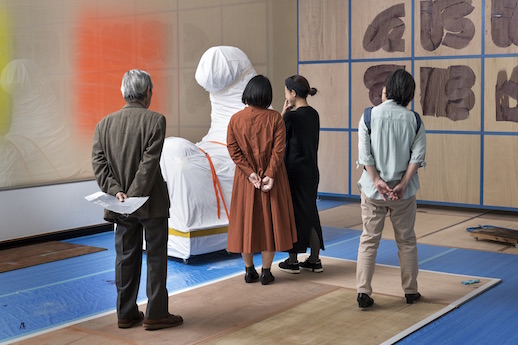
Riddle Solving and Division
The exhibition space was bustling with visitors. Many seemed to be actively enjoying the “riddle solving” aspects of the show. It was toward the end of the exhibition period, so thanks to social media, reviews, and word of mouth, many visitors probably already knew basically what the exhibition was about and came expecting to solve riddles.
The artists and the museum had taken special care that the exhibition would have no “spoilers” while it was still on show. On behalf of the artists, the museum had apparently asked reporters to avoid describing the main parts of the show in detail or to wait until the exhibition had finished to publish their reports. Like for a blockbuster film, this “no spoilers” strategy seems to have succeeded, and social media descriptions were mainly along the lines of “It’s amazingly done” and “You just have to see it for yourself” while the show drew strong visitor numbers.
With expressions of mixed uncertainty and excitement, many of the visitors devoted themselves to riddle solving, apparently knowing about the conditions of the show and wanting to see it with their own eyes. The riddle solving aspect was in fact very well done with highly skilled installation techniques and well-planned displays (and performances) throughout the space.
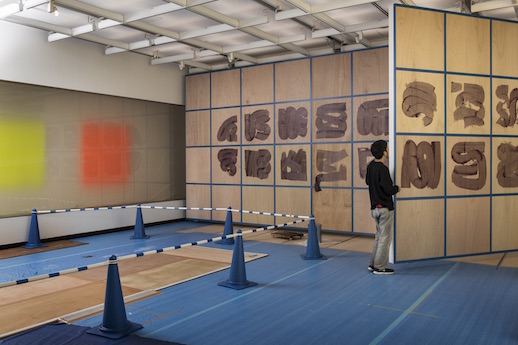
Floors seven and eight of the museum were used for exhibition space. Both floors seemed to be credibly “under construction” and appeared exactly the same way, down to the installations, art works, and dirtied plastic sheets.
These displays began with the exhibition entrance on the first floor, so it was confusing as to whether this was part of the exhibition or not – befuddling viewers as soon as they stepped inside. The museum just happened to be under renovation at the time, so some of the construction was real. To the perplexed visitor, the line between construction and art installation was blurry. Of course, this was the artists’ intent.
Furthermore, at appointed times, performers dressed like workers would appear and move objects around, remove walls, and engage in other kinds of “work.” This would temporarily upset the matching conditions of the seventh and eighth floors, but after a while the performers would restore everything to its original state.
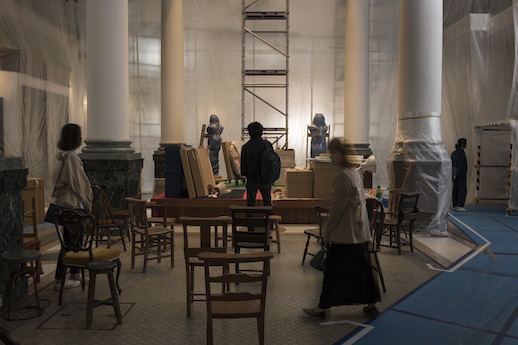
The installations at the first floor entrance were made to obscure the distinction between artwork and genuine article. Already, the curious visitor is “solving riddles.” Going back and forth and making comparisons between the seventh and eighth floors, seeing to what extent they are the same or different, trying to figure out exactly what is going on…this was the beginning of the mystery, and if time permitted you could be endlessly absorbed in it. This was because it was physically impossible to view the seventh and eighth floors at the same time, the corresponding conditions not could be fully grasped no matter how many times you went back and forth, not everything could be committed to memory, and occasional interventions by performers repeatedly broke down the status quo.
Having freely enjoyed these riddles, the visitor left satisfied. The pleasure of the elaborate displays, combined with the self-referential aspect of the contemporary art raising questions like “How much of this is artwork? Is this really a work of art?” resulted in favorable reviews on social media. “This is the first time I’ve been to such an enjoyable contemporary art show,” wrote one visitor. Of course, there were no spoilers.
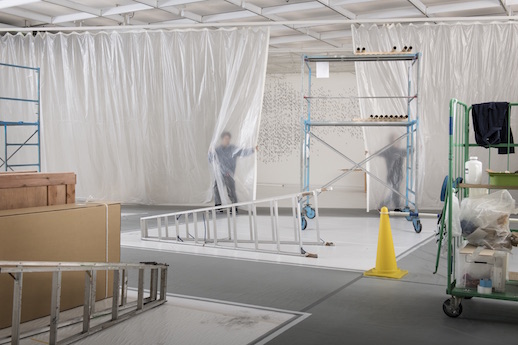
Simple questions spring to mind. What was the actual “mystery” of this exhibition? We felt as if we had fully absorbed ourselves in solving puzzles. Comparing reality and art, comparing artworks, questioning the uniformity of the artworks – we felt as if we had pursued these mysteries.
We realize that what we see and what we understand are not always clear-cut. We grasp that the borders between what an artwork is, what a museum is, and what they are not are artificial and can be interchanged at any time. The more we look, the more we think about it, the more we understand that these situations that we “cannot make heads or tales of” have been manufactured.
But is this really the mystery of the exhibition? We are reminded of doubts about what we see and what we think we understand, of questions about the systems of artworks and museums. Is this what the exhibition is for?
To make sure there wasn’t a mystery I was overlooking, I browsed through the exhibition catalog that arrived a few days later. But there was no new information there, and the contributed texts just repeated the same standard lines about “What is seeing?,” “Confronting the Uncertainty of the World,” and “Reexamining Reality.”
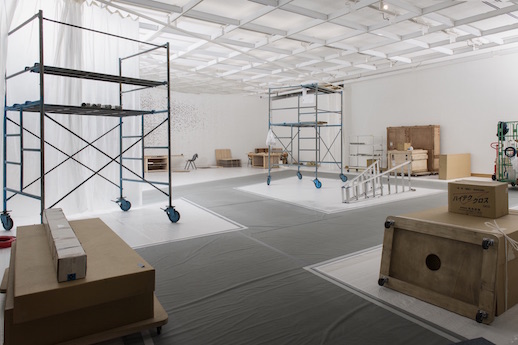
Let’s think back to the exhibition once more. In this show where it was unclear what was an artwork and what was not, or who was a visitor and who was a performer, there was a single room displaying items that were clearly works of art.
On display in that room were oil paintings from the Meiji through Taisho periods, what appeared to be small pictures, a folding screen (by Okyo Maruyama?) from the Edo period, and hanging scrolls that seemed to be from eras long ago. These works looked like they might be part of a “collection show” from the museum’s collection of works, but there was no way to be sure of that. This room, like the others, was “under construction,” with walls where artworks were not yet hung and construction tools, tables, and plastic sheets strewn about. Of course, this “collection show” area was also made to appear identical on the seventh and eighth floors.
As anyone would, I thought about how if there were real works of art from the collection on one floor, then the ones on the other floor must be imitations. The artworks were in glass cases blocked by a variety of other installations and objects, so it was difficult to distinguish if these old folding screens and hanging scrolls were the real things or not. There was one piece, however – a small oil painting of people playing on the seashore – that judging from the clumsiness of the skill and the freshness of the paint, clearly seemed like an imitation when I got a good look at it.
If this was an intentionally made (or copied?) fake, then the corresponding artwork was likely the “real thing” (or a highly skilled reproduction), possibly from the museum’s collection. Even if it was not from the collection, it was nonetheless the work of someone in the past.
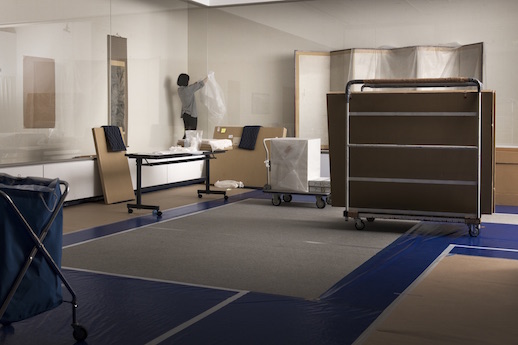
My intent here is not to critique the poor finishing of a work that is clearly a fake. That does not matter. The question is, why did these works of someone in the past displayed here have to be these ones? What are their grounds, their reasons, their meanings?
None of these works have information or credits anywhere, neither in the exhibition nor in the catalog. If pressed you could say the common point is that they are all landscapes in a broad sense. If this is the defining criterion, then, even if they were chosen from the museum’s collection, many other works could have taken their places.
The point is: For this exhibition and these artists, anything could have been chosen as a displayed work so long as it was from the museum’s collection and had a landscape motif. The same kinds of works were exhibited in the same positions in rooms on floors seven and eight, and visitors went back and forth checking for differences; as long as these conditions were in place, any kind of work by anyone would do.
Once I’d noticed this, the true meaning of the exhibition’s “mystery” that had been gnawing at me became clear. Riddle solving is certainly implemented throughout the exhibition. But these “mysteries” have no meaning – or – put another way, they are simply pretexts for setting up the conditions for riddle solving. Carefully installed installations send visitors back and forth between the seventh and eighth floors in search of these hidden mysteries. The more meaningless the mysteries are, the more visitors are driven in loops. The appeal of riddle solving that enticed so many visitors is created by the mysteries being empty.
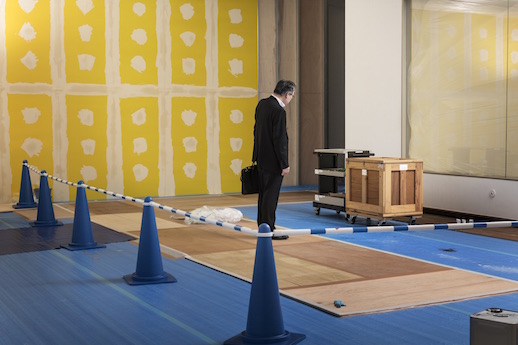
Reviewers of this exhibition will likely stress the meaninglessness of its “mysteries.” They will probably point to the need to reframe perceptions and understanding of the show so that instead of getting satisfaction from looking for the meaning of its mysteries or searching for answers, we should question the acts of looking and understanding within the time and experience of endless riddle solving.
However, I wonder if the same thing can be said for the “collection exhibition” area. Needless to say, these works come from different eras, were made by different artists, and have their own meanings completely independent of this exhibition. They did not start out as meaningless. They have been stripped of their meanings and contexts and given no basis for exhibition here. In other words, their condition of “any work could have been used” could not have worked at any exhibition but this one.
Is this “riddle solving” in which works with independent meanings and contexts are dismissed as interchangeable “materials” worthwhile in the first place? So long as the riddle solving function works, the “mystery” can be anything. Perhaps there are things to be considered and learned from the conditions produced by this premise.
To the extent that the mysteries are empty, the riddle solving goes on endlessly. This means that any surprises or anything noticed is also void of meaning. This can be understood by looking at social media impressions and comments. One art writer chose this show as among the three best exhibitions of 2019, commenting “Something this thoroughly shocking is splendid art.” I don’t know of any other comment that expressed the emptiness of the exhibition so well.
The stringent efforts to avoid spoilers was the correct strategy on the part of the artists and museum. If the details of the show were leaked, the emptiness of its mysteries would be revealed. Through this “no spoilers” approach, the emptiness was skillfully concealed, drawing visitors to the exhibition. Furthermore, the visitors who came to solve riddles were not made to think about the mysteries themselves, but were just granted the pleasure of the endless riddle solving.
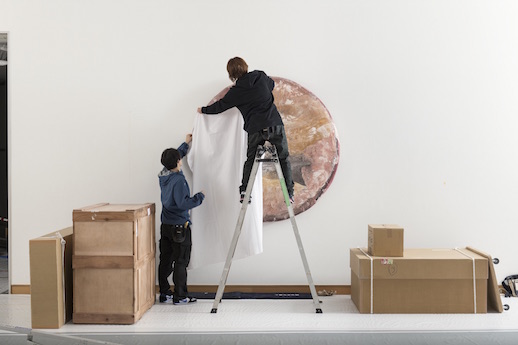
It’s worth comparing this exhibition with the outcry over Aichi Trienniale 2019, which caused a sensation in the art world with its “Freedom of Expression” segment.
The Aichi Triennale’s “Freedom of Expression” took on an abstract theme that stirred up people whether they had any interest or anything to do with contemporary art or not, accelerating divisions among people. The mé exhibition, on the other hand, gave rise to only a surface-level division about the “mystery” of to what extent something was a work of art. The riddle-solving aspect of the show also created time for contemplation.
This analysis, however, overlooks the most dangerous division brought about by the mé show. Its “no spoilers” publicity strategy created a serious division between people who had and had not seen the show. This became a topic of conversation on social media, and the more visitors increased, the deeper the division grew. The negative side of this is that positive reviews of the show only fueled the divide further.
People who had seen the show connected over a strongly shared perception that to see it was to understand it (and to not see it was to not understand it), which alienated those who had not seen it. One might think then that just by visitors coming to the exhibition the division would shrink, but this was not the case. For some who had seen the show, there was a sense of “seeing but not understanding,” which resulted in a failure of unity. Some people in this camp would likely criticize the show.
One might be tempted to say to such critics: You should have looked more closely (or continued to solve the riddles). You might say, since these critics did not completely solve the riddles, they are actually in the “didn’t see the show” camp. Not only are the show’s mysteries are meaningless, there is no way to bridge its divisions.
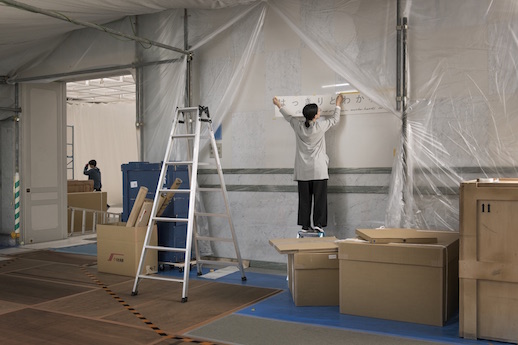
This way of handling things is just like the “enclosure strategy” of private web salons popular in recent years, where designated “experts” are idolized by cult-like users. In this situation, even if the emptiness of the exhibition is pointed out, there is still no problem. Because the riddle solving is limitless, the fault of going home without answers can be placed on the viewer.
We saw the same strategy play out with the “Black Box” exhibition of 2017. Here the organizers succeeded in attracting visitors, but users failed to circle around one point of view. Moreover, weak risk management resulted in controversy. When we think about it this way, with its publicity-linked riddle solving put in place, the mé show might be the first contemporary art exhibition to succeed in the web salon model of “user enclosure.”
Most skillful of all, with proof on social media that many visitors had enjoyed and were satisfied with the exhibition, the museum could drive drool-worthy traffic while rendering invisible the suppression of simultaneous divisions and criticism (critiques). This type of strategy at a contemporary art show might be sought not just by museums but arts festivals, shopping centers, and various other events.
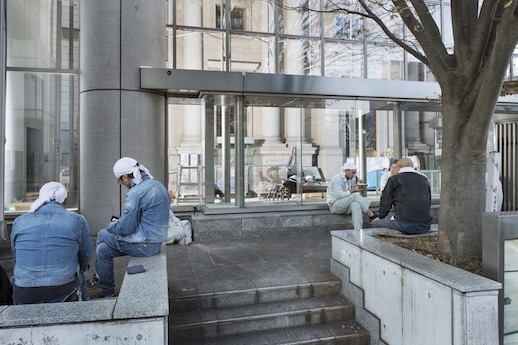
This does not necessarily mean, however, that all of mé’s works are created with the same kind of strategy. For example, its Okusoku no Seiritsu (Formation of Conjecture) (2015) at the Echigo Tsumari Art Trienniale or Repetition Window (2017) at the Reborn-Art Festival were site-specific projects outside the systems of museums. By tackling the huge theme of earthquakes, with these works mé could go beyond “riddle solving” to true mystery.
For better or worse, the enclosure strategy and division employed by this exhibition and Aichi Triennale became trademarks of 2019 art shows. However, these were certainly not mé’s best works. That’s my take, at least in the name of art criticism.
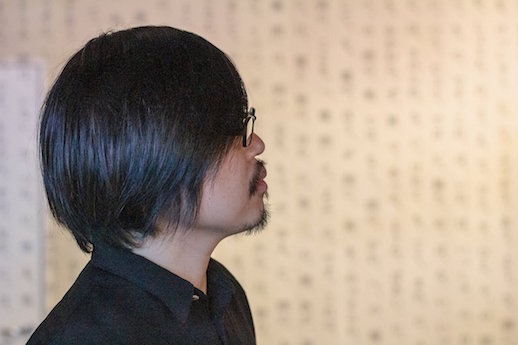
Yohei Kurose
Artist and art critic. Born 1983. Head of the art group Chaos*Lounge. Ph.D. in art from Tokyo University of the Arts.
Translated from the Japanese by Jennifer Pastore.



